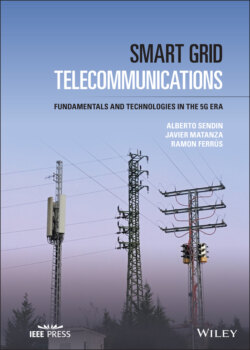Читать книгу Smart Grid Telecommunications - Ramon Ferrús - Страница 43
1.6.4 Locations to be Served with Telecommunications
ОглавлениеAll electric power grid assets potentially need telecommunication services, of one kind or another. Relying only on commercial telecommunication networks to connect these assets spread over a wide extension of territory and sometimes placed in remote (e.g. solar wind farms, transmission power lines) or hard‐to‐reach locations (SSs, meters, street cabinets, fuse boxes, etc.; they tend to be placed underground or inside metallic enclosures) is not feasible in many occasions simply due to coverage limitations, setting aside other considerations related to service control and assurance.
Commercial telecommunication networks are mainly driven by the large consumer market and, even with the universal service obligations [59] established for the telecommunications market, coverage level is dissimilar across the territory and not all citizens get access to the same portfolio and performance of telecommunication services (bandwidth, throughput, latency, etc. are usually better in urban and suburban scenarios than in rural). Coverage obligations when licences conditions are applied usually focus more on people coverage than territory, as may seem logical thinking on revenues. Moreover, even considering satellite‐based solutions offered in the market for the case of areas lacking appropriate terrestrial infrastructures (e.g. rural areas or remote locations), those solutions are not always applicable due to either technical limitations (e.g. lack of “visibility” of the satellite in valleys) or cost considerations (satellite access is currently far more expensive than terrestrial‐based solutions).
Another aspect that needs to be considered is the feasibility of the service end‐point locations to host the necessary telecommunication equipment. It is not only that a telecommunications device to provide the service is needed (with its special characteristics) but also that there needs to be enough space to install it and an appropriate power supply (in HV and MV networks, the existence of the typical LV AC or DC power is not readily available). The room aspect might become crucial, as there has been a historical trend to reduce the available space in grid assets. Even if this is something to be solved in future grid assets evolution, it is a constraint today with legacy infrastructure.
The HV segment of the electric power system do not usually has problems in terms of physical space available within premises. There are usually suitable shelters (e.g., substation control building) that have been pre‐conditioned to host electronics. The situation might be different when it applies to grid elements in the compound exterior area that may be close to grid component to be monitored, measured, or controlled. Providing power supply to these elements may require special transformers close to them or internal wiring through the substation. When it comes to cables, the situation is different, as if there is a need to incorporate some sort of monitoring along the power lines, the availability of power can be restricted to the inductive feeding possibilities.
The MV and LV grid segments are often less prepared to host electronic devices in general, and telecommunication equipment in particular. Power supply circumstances, however, are different in MV and LV, as in LV there is always AC power available by default. Thus, a combination of strategies is needed both to adapt physical spaces and telecommunication devices, where costs will be a matter of how repetitive the solutions will be and how many premises to adapt.
The variety of MV substation types is wide and any possible classification is non‐standard. A broad classification follows population density of the area where they are installed: urban areas usually present underground and in‐building type of substations (e.g., ground level and basement); suburban areas share the in‐building type with the urban areas and include the shelter‐type and the pad‐mounted transformers. In contrast, rural areas prevalently show pole‐mounted transformers. In terms of power lines, underground prevail in urban and suburban, where it gets mixed with on‐wall and overhead mounting, typical of rural.
In‐building and shelter‐type SSs are not so much a constraint in term of space as pad‐mounted constructions. Due to the lack of space in pad‐mounted and pole‐mounted SSs, there is usually the need of an outdoor enclosure. In all SSs cases, the access to LV AC power is readily available in the secondary winding of the transformer (DC power supply and battery solutions might be a concern).
However, the situation of the accessibility to LV power is more difficult in the parts of the MV grid where no SSs exist. In these places, the only standard possibility to feed electronic devices with a non‐negligible power need lays in the installation of a special transformer that increases the cost of the solution and may oblige the utility to adapt and reinforce the pole to which the element is attached. Inductive solutions may exist but are not suited for telecommunication devices needing to work in permanent operation.
The LV grid is still a challenge for telecommunications, as it has not been until very recent times when utilities have realized that, to improve the service quality, the LV grid must start to be monitored and controlled. With the likely exception of the meter locations construction, street‐cabinets and fuse boxes were never probably understood prone to host telecommunications. Meter rooms, as the result of the effort to avoid the installation of meters inside homes, are presented as built‐in wall enclosures or conditioned rooms for meters, depending on the house‐type. Thus, meter rooms and such spaces may have the capability (and the utilities the right) to host telecommunication equipment, as derived from the need to access meters for remote reading purposes. LV grid present a more amiable situation, as LV power supply is always available and there are easy and cheap ways to connect to the cables with piercing devices.
